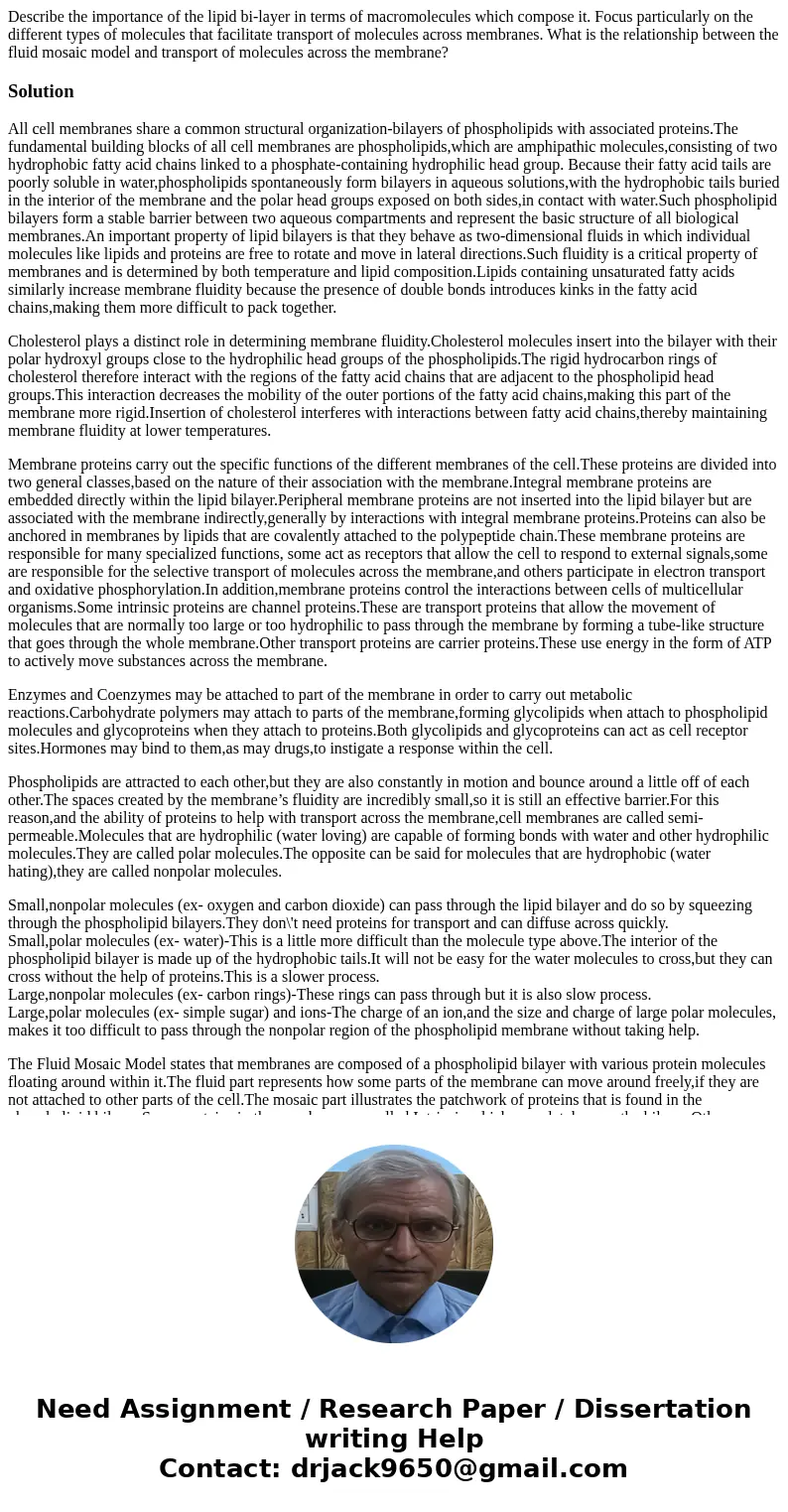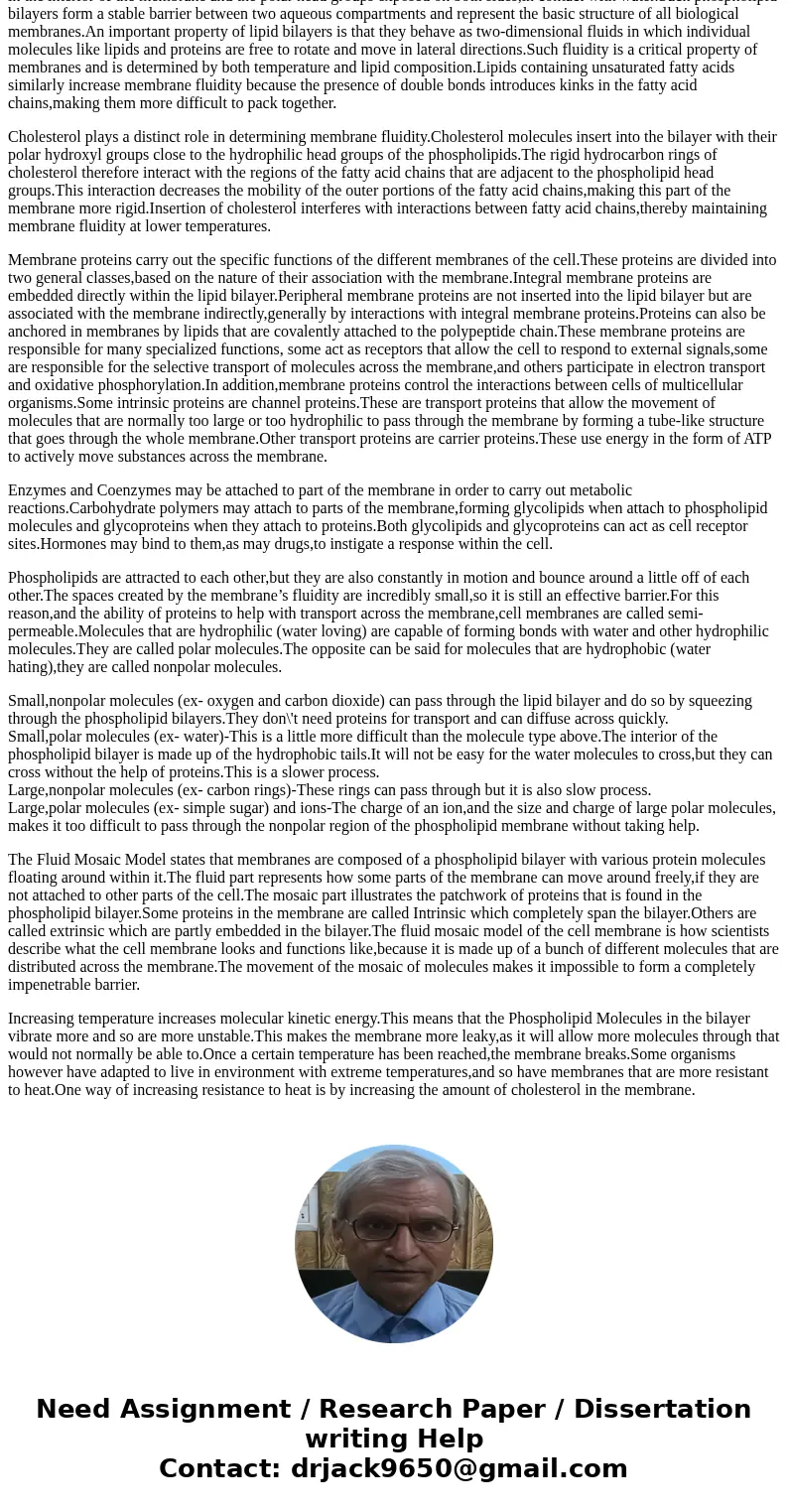Describe the importance of the lipid bilayer in terms of mac
Describe the importance of the lipid bi-layer in terms of macromolecules which compose it. Focus particularly on the different types of molecules that facilitate transport of molecules across membranes. What is the relationship between the fluid mosaic model and transport of molecules across the membrane?
Solution
All cell membranes share a common structural organization-bilayers of phospholipids with associated proteins.The fundamental building blocks of all cell membranes are phospholipids,which are amphipathic molecules,consisting of two hydrophobic fatty acid chains linked to a phosphate-containing hydrophilic head group. Because their fatty acid tails are poorly soluble in water,phospholipids spontaneously form bilayers in aqueous solutions,with the hydrophobic tails buried in the interior of the membrane and the polar head groups exposed on both sides,in contact with water.Such phospholipid bilayers form a stable barrier between two aqueous compartments and represent the basic structure of all biological membranes.An important property of lipid bilayers is that they behave as two-dimensional fluids in which individual molecules like lipids and proteins are free to rotate and move in lateral directions.Such fluidity is a critical property of membranes and is determined by both temperature and lipid composition.Lipids containing unsaturated fatty acids similarly increase membrane fluidity because the presence of double bonds introduces kinks in the fatty acid chains,making them more difficult to pack together.
Cholesterol plays a distinct role in determining membrane fluidity.Cholesterol molecules insert into the bilayer with their polar hydroxyl groups close to the hydrophilic head groups of the phospholipids.The rigid hydrocarbon rings of cholesterol therefore interact with the regions of the fatty acid chains that are adjacent to the phospholipid head groups.This interaction decreases the mobility of the outer portions of the fatty acid chains,making this part of the membrane more rigid.Insertion of cholesterol interferes with interactions between fatty acid chains,thereby maintaining membrane fluidity at lower temperatures.
Membrane proteins carry out the specific functions of the different membranes of the cell.These proteins are divided into two general classes,based on the nature of their association with the membrane.Integral membrane proteins are embedded directly within the lipid bilayer.Peripheral membrane proteins are not inserted into the lipid bilayer but are associated with the membrane indirectly,generally by interactions with integral membrane proteins.Proteins can also be anchored in membranes by lipids that are covalently attached to the polypeptide chain.These membrane proteins are responsible for many specialized functions, some act as receptors that allow the cell to respond to external signals,some are responsible for the selective transport of molecules across the membrane,and others participate in electron transport and oxidative phosphorylation.In addition,membrane proteins control the interactions between cells of multicellular organisms.Some intrinsic proteins are channel proteins.These are transport proteins that allow the movement of molecules that are normally too large or too hydrophilic to pass through the membrane by forming a tube-like structure that goes through the whole membrane.Other transport proteins are carrier proteins.These use energy in the form of ATP to actively move substances across the membrane.
Enzymes and Coenzymes may be attached to part of the membrane in order to carry out metabolic reactions.Carbohydrate polymers may attach to parts of the membrane,forming glycolipids when attach to phospholipid molecules and glycoproteins when they attach to proteins.Both glycolipids and glycoproteins can act as cell receptor sites.Hormones may bind to them,as may drugs,to instigate a response within the cell.
Phospholipids are attracted to each other,but they are also constantly in motion and bounce around a little off of each other.The spaces created by the membrane’s fluidity are incredibly small,so it is still an effective barrier.For this reason,and the ability of proteins to help with transport across the membrane,cell membranes are called semi-permeable.Molecules that are hydrophilic (water loving) are capable of forming bonds with water and other hydrophilic molecules.They are called polar molecules.The opposite can be said for molecules that are hydrophobic (water hating),they are called nonpolar molecules.
Small,nonpolar molecules (ex- oxygen and carbon dioxide) can pass through the lipid bilayer and do so by squeezing through the phospholipid bilayers.They don\'t need proteins for transport and can diffuse across quickly.
Small,polar molecules (ex- water)-This is a little more difficult than the molecule type above.The interior of the phospholipid bilayer is made up of the hydrophobic tails.It will not be easy for the water molecules to cross,but they can cross without the help of proteins.This is a slower process.
Large,nonpolar molecules (ex- carbon rings)-These rings can pass through but it is also slow process.
Large,polar molecules (ex- simple sugar) and ions-The charge of an ion,and the size and charge of large polar molecules, makes it too difficult to pass through the nonpolar region of the phospholipid membrane without taking help.
The Fluid Mosaic Model states that membranes are composed of a phospholipid bilayer with various protein molecules floating around within it.The fluid part represents how some parts of the membrane can move around freely,if they are not attached to other parts of the cell.The mosaic part illustrates the patchwork of proteins that is found in the phospholipid bilayer.Some proteins in the membrane are called Intrinsic which completely span the bilayer.Others are called extrinsic which are partly embedded in the bilayer.The fluid mosaic model of the cell membrane is how scientists describe what the cell membrane looks and functions like,because it is made up of a bunch of different molecules that are distributed across the membrane.The movement of the mosaic of molecules makes it impossible to form a completely impenetrable barrier.
Increasing temperature increases molecular kinetic energy.This means that the Phospholipid Molecules in the bilayer vibrate more and so are more unstable.This makes the membrane more leaky,as it will allow more molecules through that would not normally be able to.Once a certain temperature has been reached,the membrane breaks.Some organisms however have adapted to live in environment with extreme temperatures,and so have membranes that are more resistant to heat.One way of increasing resistance to heat is by increasing the amount of cholesterol in the membrane.


 Homework Sourse
Homework Sourse